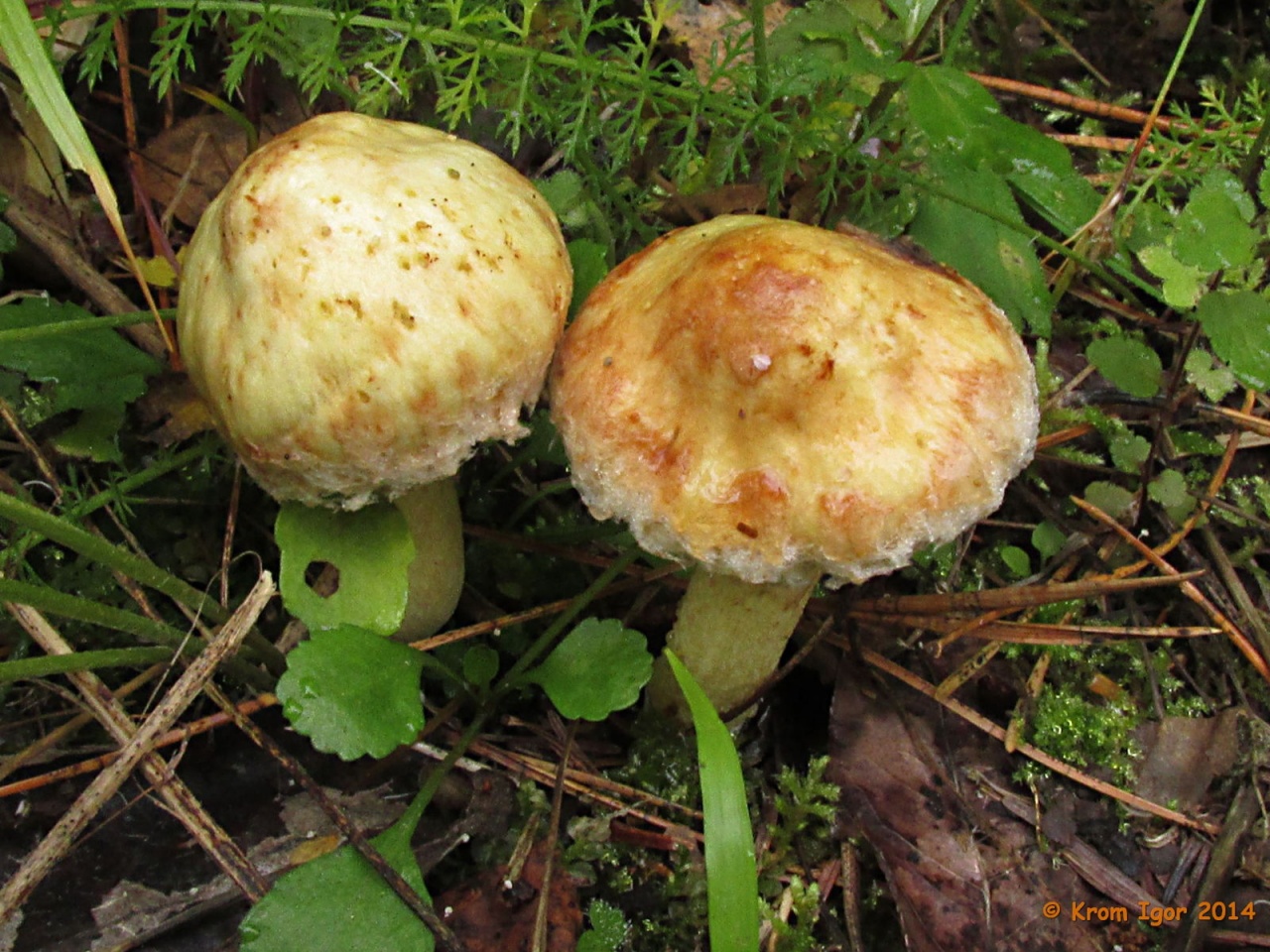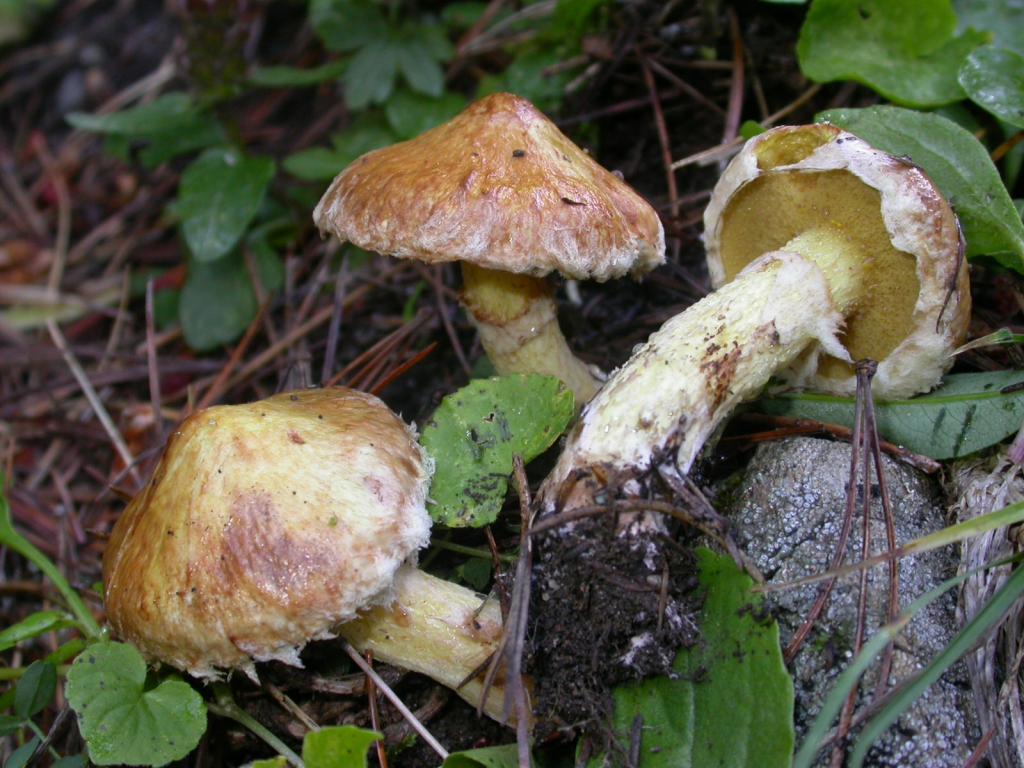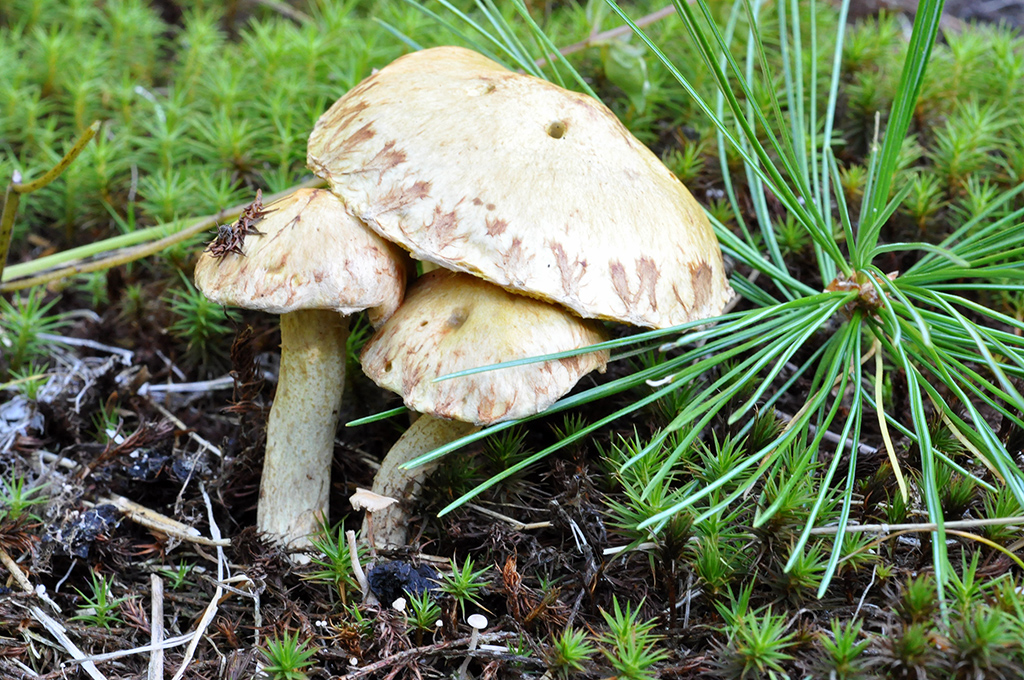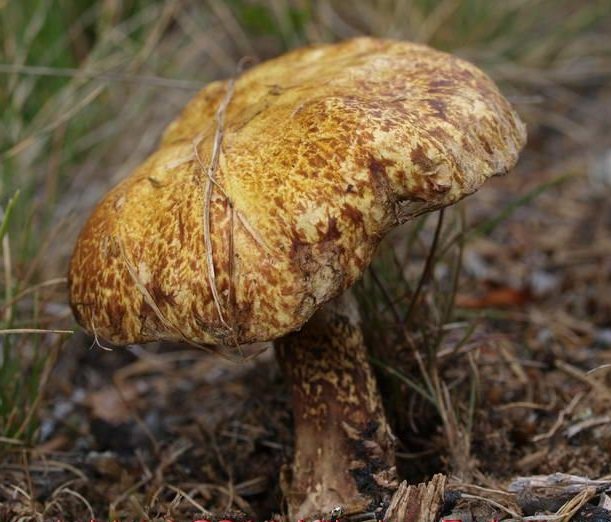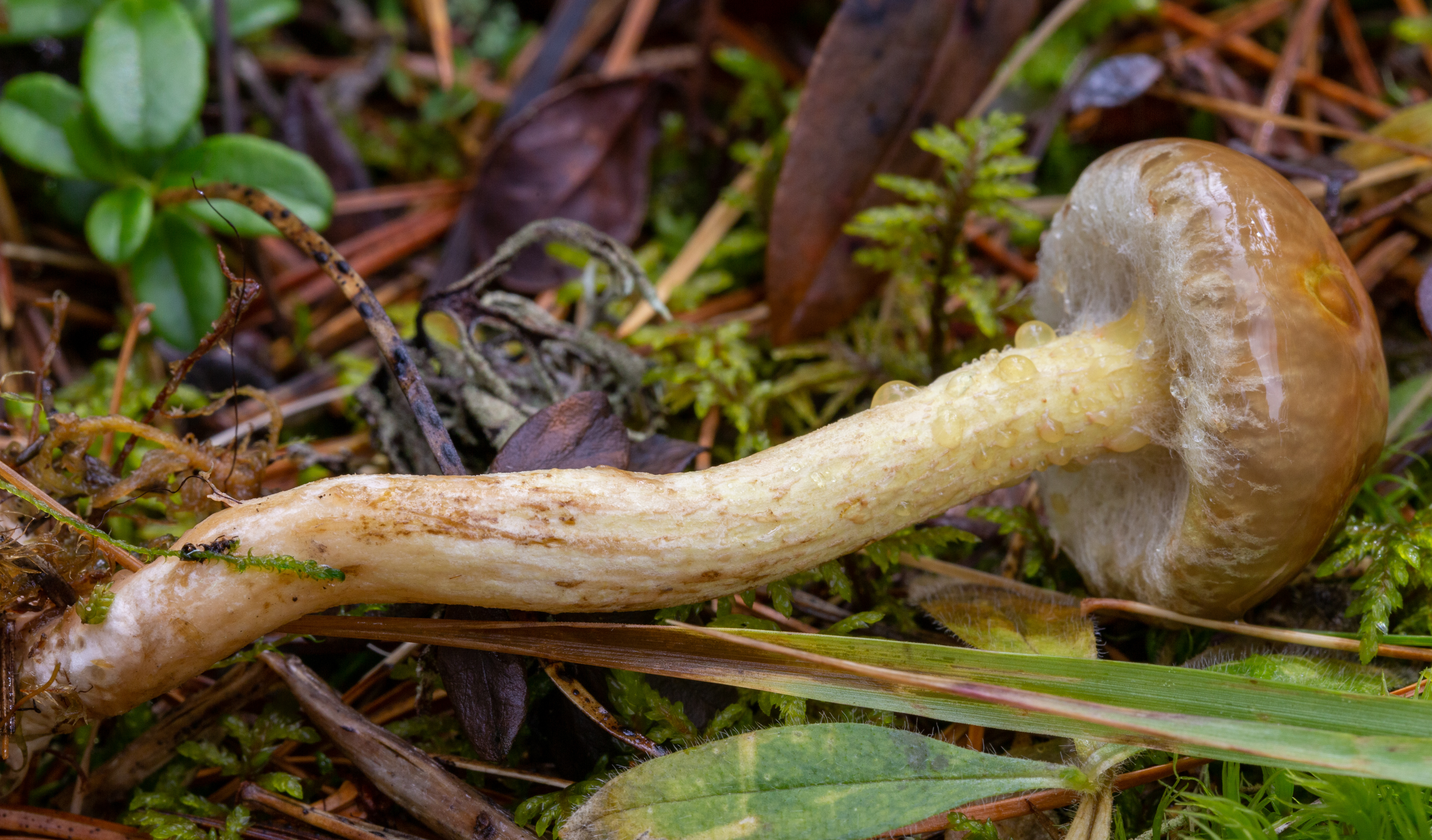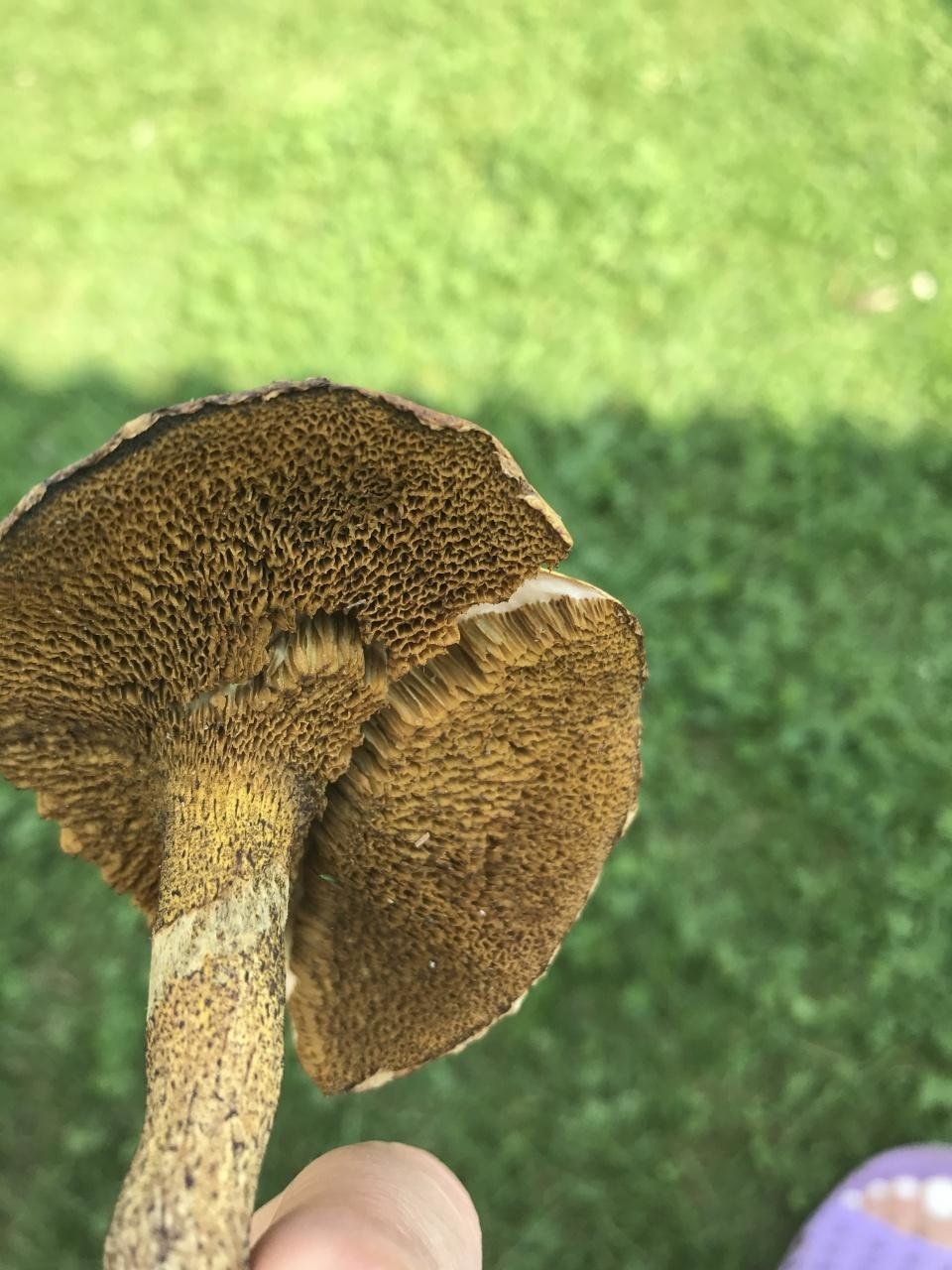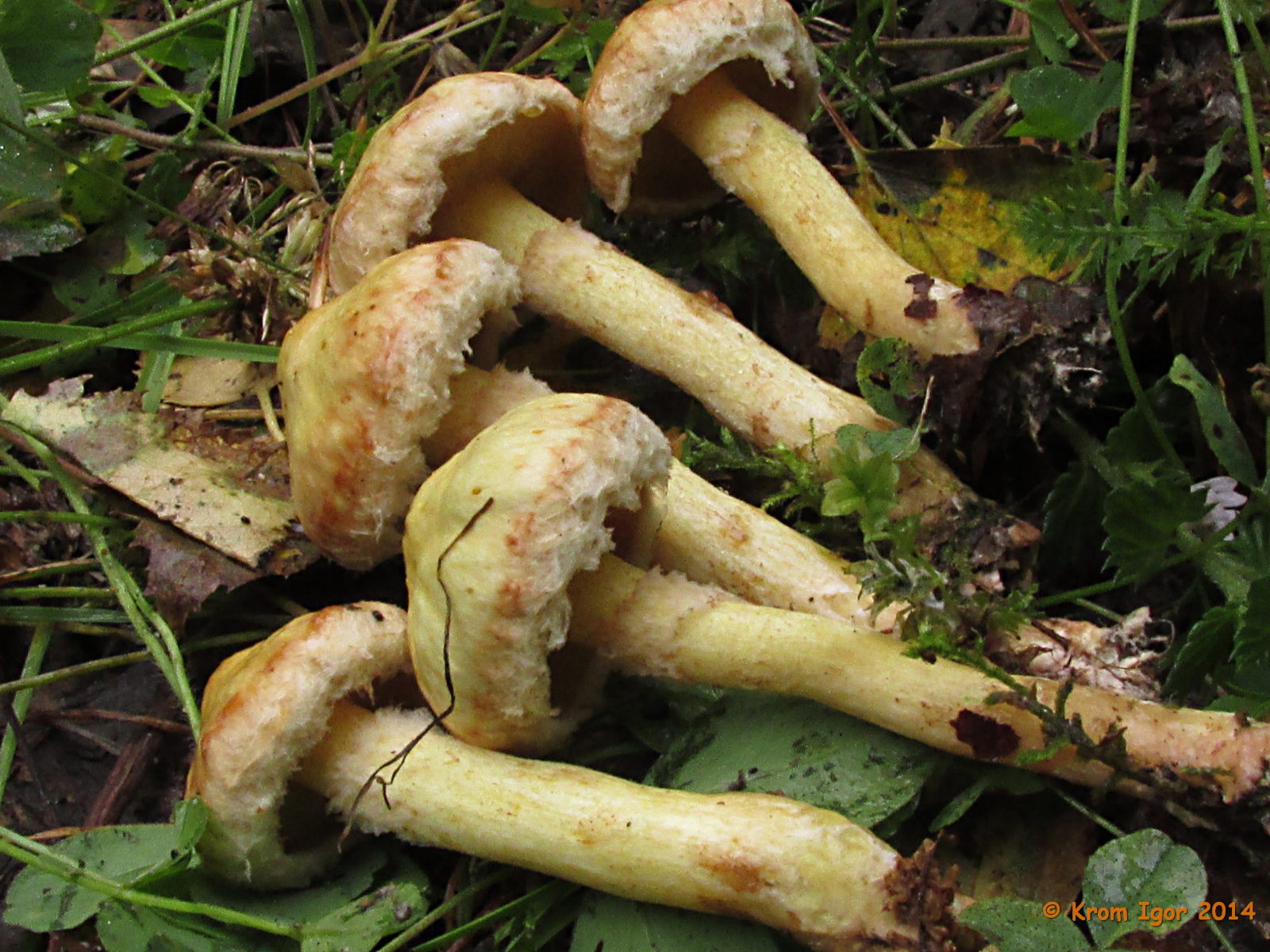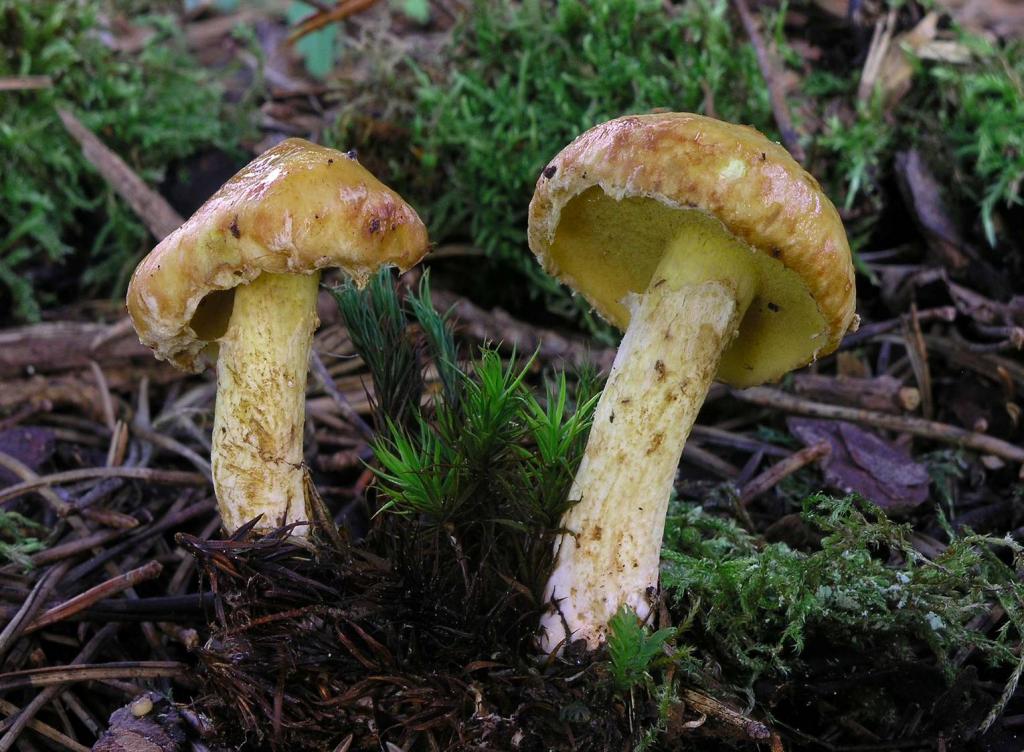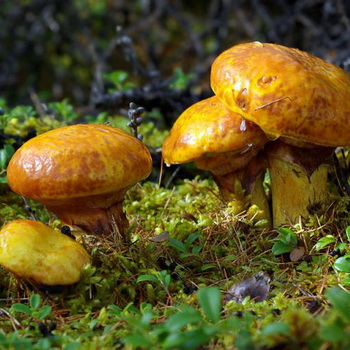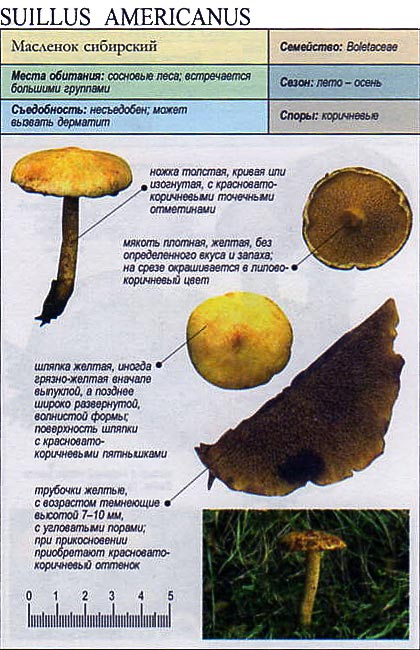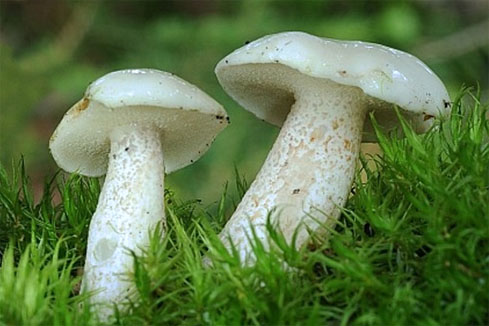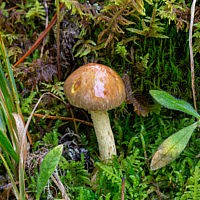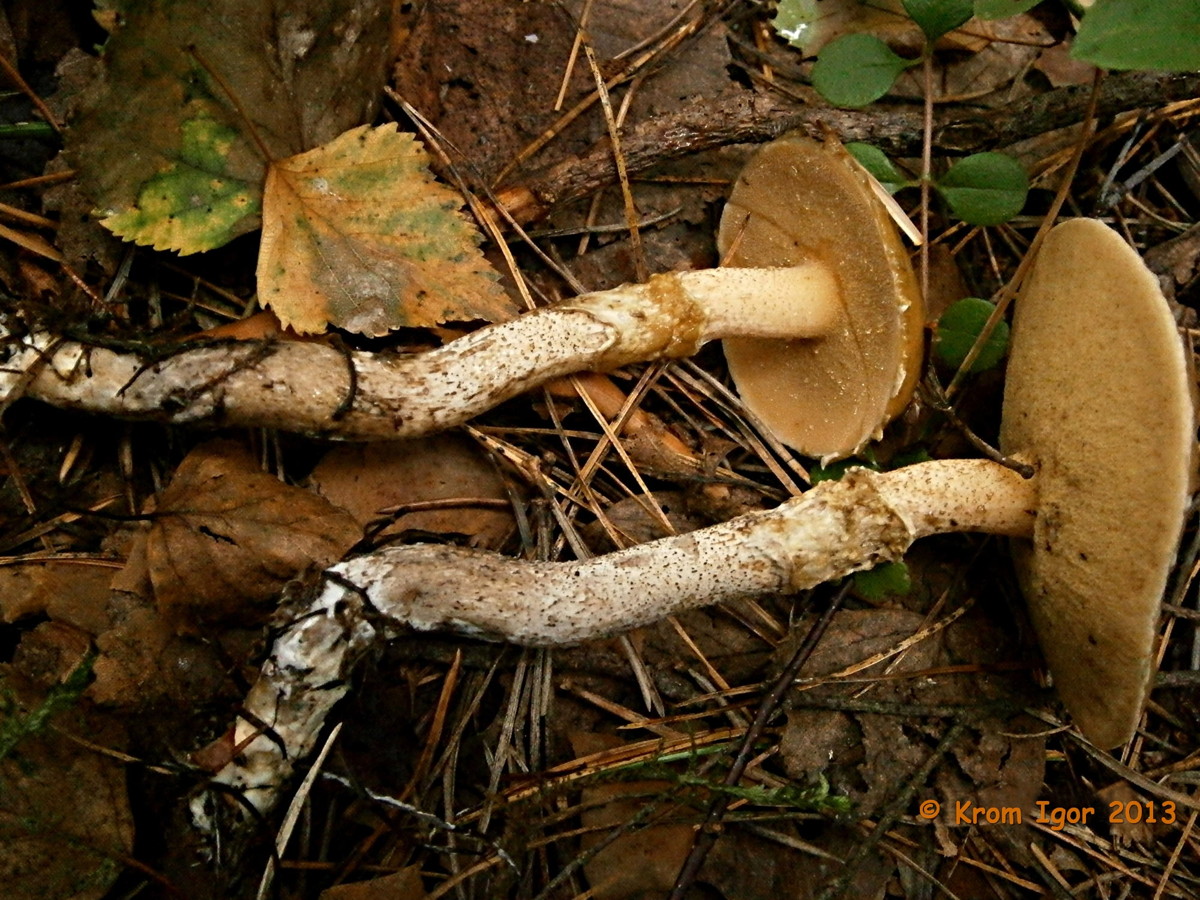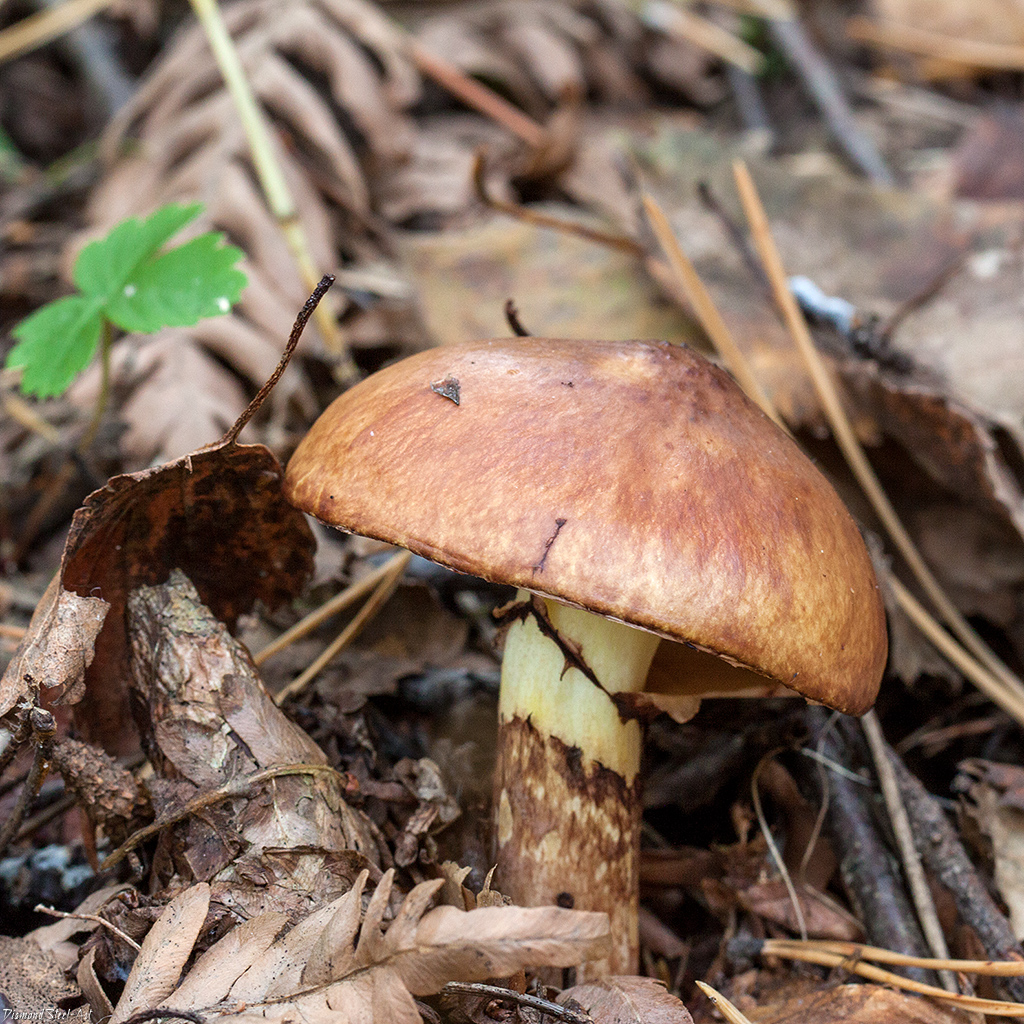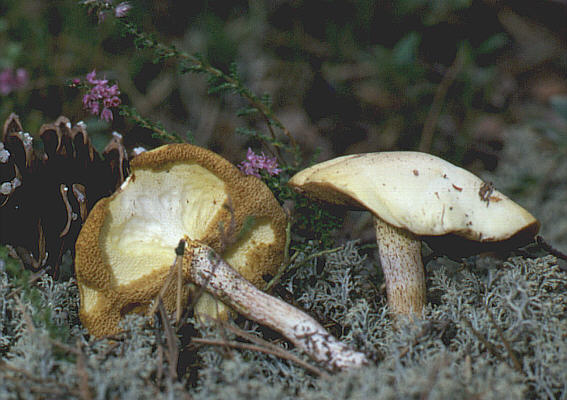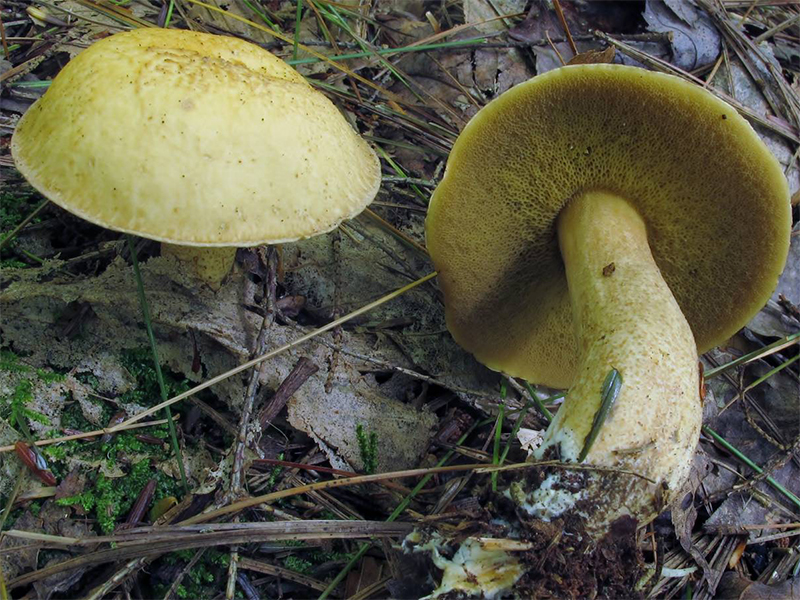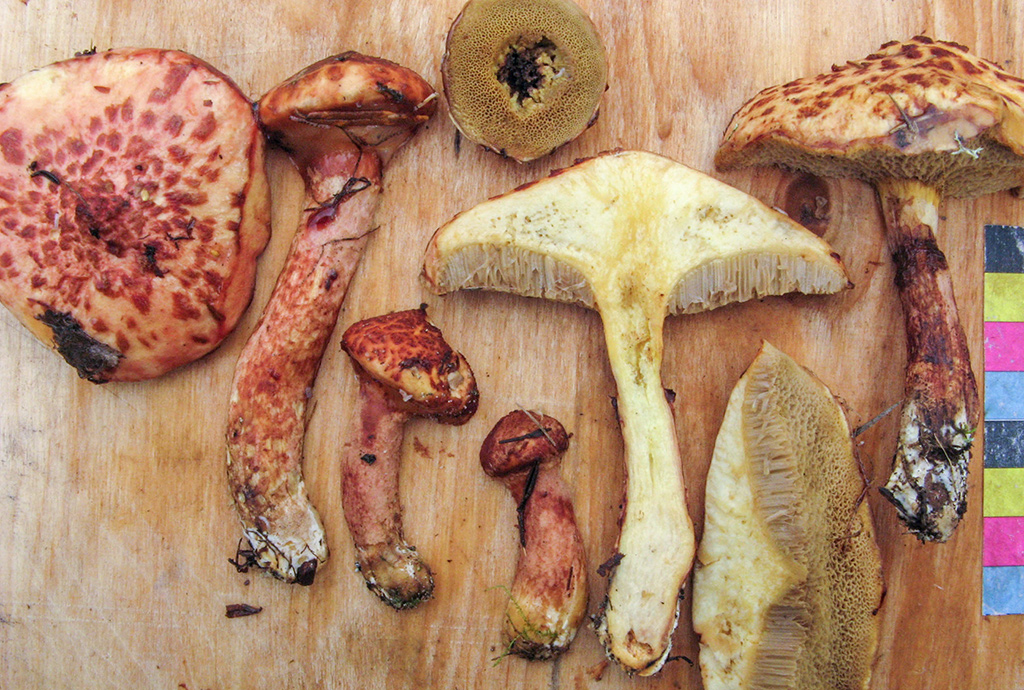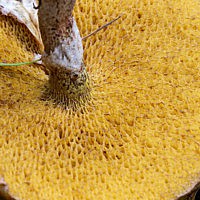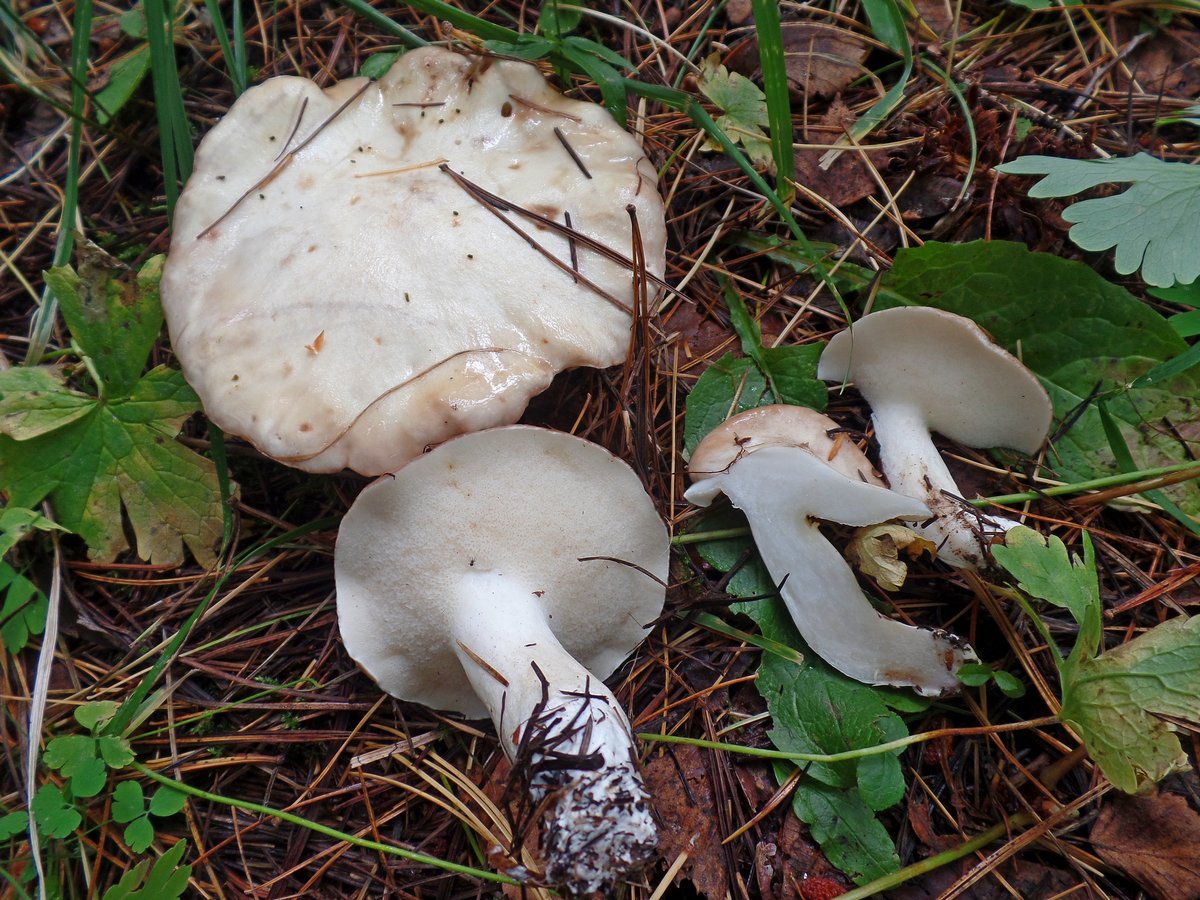Nyusha's butter dish

I will immediately disappoint the blondes: this mushroom, despite its - as it seems at first glance - "cute little name", was not named after some girl Anya. I was in Third Reich pre-war Germany, botanist Emil Nusch, that's his surname and immortalized in the scientific name of this oil can.
Nyusha's butter dish has a very expressive appearance: its hat is brown on top, sometimes lemon-yellow, the leg also has a similar color, only a little lighter. The tubes, on the contrary, are not so bright, but light gray. Young fruiting bodies from the bottom of the cap have a ring-cover, consisting of two layers: the upper one is film, and the lower one is more like cotton wool.
This is another type of boletus that forms mycorrhiza with larch and grows where this tree is found. It is found in various places throughout the continent - in Europe, in the Urals and in Siberia. An interesting feature was noticed behind the mushroom - it can climb quite high into the mountains - up to the very upper border of the forest. Nyusha's oiler bears fruit from July to October.
In terms of nutritional quality, it is quite good.
Recipes for cooking dishes and preparations
Delicious and healthy boletus is loved not only by people, but also by numerous forest dwellers. Therefore, the best harvest is harvested early in the morning, trying to get ahead of insects, as well as in cool autumn weather.
Fruit bodies are thoroughly cleaned, discarding the wormy parts and removing the skin. To make it easier to remove, the mushrooms are immersed in slightly salted boiling water for 2-3 minutes, then quickly immersed in cold water, and thrown back onto a sieve.
Pickled boletus
For the marinade, based on 3 kg of mushrooms, take 2 cups of 8% vinegar, 1 glass of water, 3 tablespoons of salt, 3 teaspoons of sugar, bay leaf and black peppercorns.
The peeled mushrooms are dipped in a boiling marinade and boiled over low heat for 20 minutes. Packed in jars, poured with warm marinade, cooled and placed in the refrigerator. The workpiece is ready for use in 30–35 days. Before serving, the product is washed, chopped onions are added, flavored with vegetable oil. This is a wonderful side dish for meat roast.
Mushrooms in oil
The previously cleaned fruit bodies are cut in half and put in boiling water for 1–1.5 minutes, after which they are thrown into a colander. Immersed in jars, they are poured with olive or refined sunflower oil, making sure that they are completely covered, covered with lids and placed in a flat pan with cold water.
The water is brought to a boil and boiled over low heat for 25 minutes. The workpiece is cooled, reheated until the oil boils in cans and sealed.
Butter in white wine
The water is brought to a boil, slightly salted and acidified with citric acid. Mushrooms blanch for 5 minutes over low heat, strain and put in prepared jars. The resulting brine is diluted in half with white wine and poured on top, after which it is sterilized for 40 minutes. This delicious, aromatic and healthy appetizer is especially good for poultry and meat dishes.
Views
The genus Oiler unites about 40-50 species [source not specified 2953 days].
| Cat. * | Latin name | Russian name | ||||||||||
|---|---|---|---|---|---|---|---|---|---|---|---|---|
| Suillus aeruginascens | Greyish oiler, blue larch oiler | |||||||||||
| Suillus bellinii | Bellini Butter Can | |||||||||||
| Suillus bovinus | Goat, sieve | |||||||||||
| Suillus clintonianus | Belted butter dish | |||||||||||
| Suillus flavidus | Swamp butter dish, yellowish butter dish | |||||||||||
| Suillus granulatus | Granular oiler, summer oiler | |||||||||||
| Suillus grevillei(Suillus elegans) | Larch butter dish | |||||||||||
| Suillus luteus | Butter can ordinary, oil can late, oil can yellow, oil can real, oil can autumn | |||||||||||
| Suillus piperatus | Pepper butter, pepper mushroom | |||||||||||
| Suillus placidus | Butter can white, oiler pale, oiler soft | |||||||||||
| Suillus plorans | Cedar butter dish | |||||||||||
| Suillus rubinus | Ruby butter dish | |||||||||||
| Suillus salmonicolor | Butter dish yellowish | |||||||||||
| Siberian butter dish | ||||||||||||
| Suillus spectabilis | Oiler remarkable | |||||||||||
| Suillus tridentinus | Butter can red-red | |||||||||||
| Suillus variegatus | Butter dish yellow-brown, butter dish marsh | |||||||||||
|
Complete list of species
|
Description
The scientific name for boletus - Suillus comes from the Latin noun sus, meaning pig. Therefore, Suillus means "pork" and refers to the fatty cap, which is common to different types of boletus.
Boletus mushrooms are distinguished from other mushrooms by:
- slimy caps;
- radially or randomly located pores;
- the presence of a partial cover between the cap and the leg;
- glandular specks;
- habitat among coniferous vegetation.
Unfortunately, many types of boletus mushrooms have only a few of these characteristics.
As mentioned above, one of the most obvious characteristics of oil is a slimy cap. Of course, the surface may not be very sticky in dry weather, but signs of a mucous layer are visible because debris adheres to the cap. In dried specimens, the cap coating also remains quite shiny.
In addition to the slimy texture, the cap is not very characteristic of this fungus, reaching 5-12 cm in diameter. It is round and convex, but smoothes over time. It is mostly brown in color, although it ranges from dark brown to reddish brown to yellowish brown.
The surface of very small pores is whitish to light yellow in color. In some types of oil, the pores are located randomly, in others radially. With age, the pores darken and become yellow to greenish-yellow in color. The spores that form in the pores are brown in color. In young fungi, the pore surface is partially covered with a veil. This blanket is mostly white and rips open the pore surface when the fungus forms spores. On mature mushrooms, the remnants of a partial veil can be seen as a ring around the stem and small pieces of tissue remain along the edge of the cap.
Butter mushrooms are rather squat, medium-sized mushrooms with a solid cylindrical stem 3-8 cm long, 1 to 2.5 cm wide. Some species have a ring formed from the remnants of a partial as the fungus develops). It is initially white, then slowly takes on a purple hue, especially on the underside. Above the ring, the whitish leg fades to match the cap near the top.
This part of the peduncle is also adorned with numerous clusters of cells called glandular punctures. These glandular dots darken with age and stand out from the rest of the peduncle in adulthood. Glandular dots appear as a result of cell swelling and resemble tiny bumps.
Butterlets (Suillus). Description, distribution and types of oil
It's already the middle of summer, which means that the "mushrooming" begins! And to remind you of some useful information about mushrooms, today we will talk with you about boletus. How can we live without them, in our native forests? Indeed, in terms of popularity and taste, boletus are not particularly inferior to their "white" fellow citizens, who, moreover, are their relatives. So…
Butter dish (Latin Suillus) is a genus of tubular mushrooms of the Boletovye family (Latin Boletaceae).
Category: edible mushrooms.
The oiler got its name from the cap that is oily (slippery) to the touch.
The main difference between the oiler and other painful mushrooms is the cap, which is slippery to the touch, from which the skin can be easily removed. In addition, under the cap there may be a light coverlet, which in adult mushrooms leaves only a trace of its early presence at the top of the stem.
Ordinary butter dish
- Latin name: Suillus luteus.
- Synonyms: real butterdish, late butterdish, yellow butterdish, autumn butterdish.
Typical species of the genus boletus, very widespread throughout the continent. Has a characteristic, very memorable appearance. The main distinguishing feature of this mushroom is a powerful ring-veil under the cap, which in young fruiting bodies is connected to the edge of the hymenophore.
The common oiler forms mycorrhiza with Scots pine (as well as other pines, in which the needles consist of two needles). That is why he comes across in pine and pine forests mixed with pine, preferring well-warmed places - edges, glades, forest roadsides. Fruiting in dense groups - from June to October, most massively - in late summer and early autumn. In especially fruitful years, up to seven "waves" of mushrooms can be observed. At a temperature on the soil surface of -5 ° C, fruiting bodies cease to appear, but if the ground does not have time to freeze up to 2-3 centimeters and warming comes, the mushrooms will begin to grow again.
When collecting, among the boletus, there will certainly be wormy ones, and in some places to such an extent that there are only three clean ones for a dozen. This is especially evident in the summer. In autumn, when it gets colder, the number of wormy mushrooms decreases markedly. It is also noticed that the very first boletus are without worms.
The mushroom is edible, in terms of taste it is the best among butter. It can be fried, boiled, marinated, salted and even dried. In the case of salting and pickling, it is recommended to remove the skin from the caps, otherwise it will cause the brine to become dark and very thick.
It is worth noting the fact that according to traditional Russian cuisine - the peel from butter should always be removed, regardless of what kind of dish is to be prepared.
general characteristics
Oil loves are light-requiring. The most common and successfully grow in both coniferous and mixed forests. It is difficult to find them in dark thickets, therefore, the collection usually takes place in meadows, along the sides of roads and paths.






The mushrooms got their name because of the peculiarity of the cap. The oil cover on their surface has a significant viscosity and is covered with sticky mucus, as evidenced by the frequent adhesion of pine needles, leaves and dry grass. The hat usually has a convex or flat shape and is smooth. When you feel it, you can find a characteristic sticky substance. Immediately after cutting the mushroom, its pulp in this place acquires a bluish or red tint. The spores and the powder they consist of are colored yellow.
Poisonous species
Poisonous boletus are called false. On the territory of our country, you can find the three most common types. In order not to get into a difficult situation, not to be treated for the consequences of poisoning for a long time and not accidentally bring a dangerous mushroom from the forest, you need to familiarize yourself with them.
Among them:
- The buttercup is yellow-brown in color, which immediately after the cut of the leg acquires the characteristic blue color of the flesh. Like the usual edible type, it grows from mid-summer to late autumn, right up to the first cold weather. You can meet him in swampy areas of coniferous forests. The cap most often reaches a large size, equal to 15 cm in diameter. The main difference between the mushroom is the characteristic color of the skin and scales of a dark yellow color. Has no characteristic gloss. The shape of the leg is cylindrical, has a dense structure and a brownish tint. There is no ring on it, which is formed in edible oil. The mushroom is not allowed to be consumed under any circumstances. Considered conditionally edible.
- The Siberian species grows in groups. It grows only in coniferous forests. The hat has a specific pale color with a yellow tint. Red specks appear on mature mushrooms. The dense structure of the pulp is odorless and tasteless. Over time, the cut takes on a repulsive purple or brown hue. The leg, unlike edible mushrooms, is always crooked, covered with small specks. It can get into the mushroom picker box from early summer to late autumn.
- Spruce peel resembles a butterdish externally, although it is not. It is often brought home by amateur mushroom pickers, and therefore it must be included in the list of poisonous mushrooms. The mushroom can be found from mid-summer to late autumn in coniferous and mixed forests. The main advantage is that it is extremely difficult to find it. Like butter, the cap of the moss is covered with sticky mucus. Has a specific gray tint. There is a webbed structure under the cap, which differs from the spongy oiler. The characteristic gray or brownish tint takes on only closer to autumn. Therefore, it is often confused with the gray edible mushroom species.
Butterlets have always been an integral part of Slavic culture. They were collected in large quantities in the forests, salted and pickled, added to the first courses. The mushroom has an unusual and rich taste and aroma. Not surprisingly, it remains very popular among modern mushroom pickers. However, even such a feature as a slimy cap is not always its primary sign of edibility. Therefore, in the forest, you should behave carefully and carefully choose only really healthy mushrooms. The above description will help during collection not to bring poison to the family.
Definitioner
- Basidia (Basidia)
-
Lat. Basidia. A specialized structure of sexual reproduction in fungi, inherent only in Basidiomycetes. Basidia are terminal (end) elements of hyphae of various shapes and sizes, on which spores develop exogenously (outside).
Basidia are diverse in structure and method of attachment to hyphae.
According to the position relative to the axis of the hypha, to which they are attached, three types of basidia are distinguished:
Apical basidia are formed from the terminal cell of the hypha and are located parallel to its axis.
Pleurobasidia are formed from lateral processes and are located perpendicular to the axis of the hypha, which continues to grow and can form new processes with basidia.
Subasidia are formed from a lateral process, turned perpendicular to the axis of the hypha, which, after the formation of one basidium, stops its growth.
Based on morphology:
Holobasidia - unicellular basidia, not divided by septa (see Fig. A, D.).
Phragmobasidia are divided by transverse or vertical septa, usually into four cells (see Fig. B, C).
By type of development:
Heterobasidia consists of two parts - hypobasidia and epibasidia developing from it, with or without partitions (see Fig. C, B) (see Fig. D).
Homobasidia is not divided into hypo- and epibasidia and in all cases is considered holobasidia (Fig. A).
Basidia is the place of karyogamy, meiosis and the formation of basidiospores. Homobasidia, as a rule, is not functionally divided, and meiosis follows karyogamy in it. However, basidia can be divided into probasidia - the site of karyogamy and metabasidia - the site of meiosis. Probasidium is often a dormant spore, for example in rust fungi. In such cases, probazidia grows with metabasidia, in which meiosis occurs and on which basidiospores are formed (see Fig. E).

See Karyogamy, Meiosis, Gifa.
- Pileipellis
-
Lat. Pileipellis, skin - differentiated surface layer of the cap of agaricoid basidiomycetes. The structure of the skin in most cases differs from the inner flesh of the cap and may have a different structure. The structural features of pileipellis are often used as diagnostic features in descriptions of fungi species.
According to their structure, they are divided into four main types: cutis, trichoderma, hymeniderma and epithelium.
See Agaricoid fungi, Basidiomycete, Cutis, Trichoderma, Gimeniderm, Epithelium.
Siberian butter dish

Some boletus have such an unusual appearance that you can confuse them with filthy mushrooms and, for fear of being poisoned, pass by. However, the Siberian Butter, in his youth, distinguished by conical caps covered with white rags, is quite suitable for food.
Siberian butter dish - Latin Suillus sibirikus
In another way, the mushroom is called American Butter.
Description
Mushroom cap
The American oiler has an uneven, bumpy, medium-sized hat that grows up to 40-100 mm in diameter. Young boletus are equipped with "headdresses" in the form of wide cones, which become cushion-shaped and outstretched as they grow, crowned with a mild mound and flakes of the former bedspread hung around the edges. The edges are often bent upward.
The hat itself is covered with a damp skin, on which a lot of mucus appears on rainy days. The skin is pale yellow, yellow-olive, greyish-yellow, and is streaked with ingrown reddish-brownish radial filaments or scales.
The caps are filled with yellowish or rich yellow flesh. If cut or broken, it usually does not change color, but in rare cases it becomes pinkish or brownish.
Hat bottoms are filled with a yellow tubular mass of wide, narrowing to the edges of the tubes, which run down well on the legs or grow to them. The pores of the tubes, which are characterized by an angular shape, are painted in a yellowish tint, eventually becoming a honey or dirty ocher hue. When pressed or damaged, they turn brown, pinkish or wine-colored.
Pale yellow droplets appear on the tubular layer of the young Siberian Oily.
In youth, the tubes are covered with a white, light yellow or pinkish filmy fleecy coverlet, from which later only rags and a foot ring remain.
American boletus breeds as smooth, elongated, yellow spores that emerge from a brown spore powder.
Stipe
Siberian boletus has curved cylindrical legs, thinning downwards and reaching 10-20 mm in thickness and 50-110 mm in height. It has a yellowish or sulfur-yellow color, sometimes turning into wine at the base.
On young stems, yellowish droplets are allocated, gradually turning into brown or brownish-red glandular specks or scales.
From the torn coverlet, fibrous rings of a pale yellow or pinkish hue remain on the legs. They gradually thin out, becoming sticky, dry out and disappear, especially if it is a dry season.
Places of growth and fruiting
The American oiler chooses for growth a soil substrate of coniferous forests with Siberian cedars, five-coniferous pines and dwarf cedar trees, and also inhabits mixed forests with coniferous and deciduous species.
It is collected in lowland and mountain forests: Altai, Sayan, Far Eastern, Estonian, Alpine, Balkan, North American, Chinese and Himalayan.
Fruiting occurs in large groups or singly, and lasts from June to September.
Edibility
The taste characteristics of this butter dish depend on the growing conditions: in some regions it is almost tasteless, in others it is sour, in others it is bitter. The smell can also be mild or very faint.
The mushroom is considered fit for food and belongs to the 4th category. It can be fried, salted, stewed, marinated and put in soups.
- The butter dish is sour. It differs from its Siberian counterpart in a non-disappearing ring, darker specks on the legs and a pronounced sour taste.
- Cedar butter dish. It is distinguished by a darker color of hats and legs.
Description of cedar oil can
A cedar oiler's cap in diameter ranges from 3-15 centimeters. In young butterflies, the shape of the caps is hemispherical, but as it grows, it becomes cushion-shaped, while sometimes there is a tubercle in the center. The surface of the cap is fibrous. Its color is brown. During wet weather, the cap becomes greasy, but dries quickly and becomes waxy.
The pulp is orange or yellow. The pulp has a pleasant fruity-almond smell, and the taste is slightly sour. The tubules are orange-brown, off-yellow or olive-ocher colored. The pores are the same color as the tubes. Drops of milky-whitish liquid are released from the pores, which dry up and form brown spots. The spore powder is brown.
The height of the leg of a cedar oiler is 4-12 centimeters, and the thickness reaches 1-2.5 centimeters. The base of the leg is thick, and at the top it tapers. The leg is solid in structure. Its color is ocher brown. Milky drops are released from the leg, and its surface is covered with grains, which eventually turn black.
Places of growth of cedar boletus
From the name it becomes clear that these mushrooms grow in cedar and coniferous forests. Most often, pine boletus is found in dry forests and lichen pine forests. These mushrooms prefer new plantings and small conifers.
Cedar oil is quite common in the Far East and Siberia. They grow alongside Siberian and Korean cedars, as well as dwarf cedars. Cedar boletus is the most common type of boletus in Siberia. These mushrooms are most abundant in forests on the southern slopes. They bear fruit from August to September. Pine flowering indicates that it is time to collect boletus.
Description [2]
The cap is 5-12 cm in diameter, in young mushrooms it is convex, cushion-shaped, then flattened, sometimes concave. The color of the cap of young mushrooms is whitish, pale yellow at the edges, then grayish or yellowish-white, darkening to dull olive in damp weather. The surface of the cap is smooth, bare and slightly slimy; when dry, it is shiny. The skin is easily removable.
The pulp is dense, white or yellowish, light yellow above the tubes. At the break, it slowly changes color to wine red; according to other sources, does not change color. Mushroom taste and smell, expressionless [source not specified 25 days]. In KOH, the flesh is wine-red; in ammonia it is red.
adherent to the peduncle, sometimes slightly descending. The tubules are 3-8 mm deep, whitish-yellow, later lemon-yellow, then olive-yellow, olive-brownish. The pores are small (2-4 per mm), angular-rounded, monochromatic with tubules, often with droplets of reddish liquid, usually olive-brownish at maturity from spores.
Leg 3-9 cm x 0.7-2 cm, cylindrical, sometimes fusiform towards the base, eccentric or central, often curved, solid, white, yellowish under the cap. At maturity, the surface is covered with reddish-violet-brown spots and warts, merging in places into ridges. The ring is missing.
Microstructures
Spore powder is light brownish, ocher, yellowish-olive. Spores 7-11 x 3-4 microns, ellipsoidal, fusiform-oval, smooth, hyaline, in Melzer's reagent - pale yellow, non-amyloid.
Basidia 24-28 x 6-7 microns, in KOH - hyaline, in Melzer's reagent - yellowish, clavate, two- and four-spore. Pleurocystids 49-60 x 6-9 µm, from subcylindrical to clavate, with dark brown intracellular and encrusting pigment; cheilocystids and caulocystids are similar to pleurocystids, but more capitate. The trama of the tubules is divergent. The surface of the cap is composed of narrow (3–6 µm) pale yellow hyphae. There are no buckles.
Caution, boletus!
In addition to useful properties, boletus has some negative effects on the body. So, the fiber in the oiler is saturated with chitin, which interferes with the good digestibility of these mushrooms. Therefore, it is not recommended to use a large amount of oil can. Experts say that chitin is not only not digested in the human gastrointestinal tract, but also makes it difficult for digestive juices and digestible substances to access. The digestibility of mushrooms will deteriorate, in particular, also by the fact that mushroom proteins mainly belong to difficultly soluble substances.
Doctors consider mushrooms to be difficult to digest.
Butter dish white
Butter dish white - Latin suillus placidus
In a different way, such a fungus is called a Buttercup soft or Buttercup pale.
Description
Mushroom cap
The diameter of the pallid oiler's hats reaches 50-120 mm in diameter. At first, the hat has a shape in the form of a convex pillow, a little later it becomes flatter, and sometimes even concave.
The hats are covered with an easily separating glossy skin, in young mushrooms they are whitish with yellowish edges, in adults they are yellow-white or white-gray. During rains, the skin darkens to a pale olive shade and becomes covered with a thin layer of mucus.
"Hats" are filled with tight white or pale yellow flesh that turns yellow over the tubular mass and takes on a purple tone under the skin. When damaged, the color of the pulp gradually becomes reddish - wine color.
The hat bottom is formed by a tubular layer of tubes from 5 to 11 mm long adhering to the legs. They are painted in a pale yellow color, eventually turning into yellow-olive.
The soft butter dish reproduces by smooth, elongated olive-yellow spores that form in a brown ocher spore powder.
Stipe
The white oiler builds up a cylindrical, occasionally bending and tapering leg with a diameter of 7-20 mm and a height of 30-90 mm. It is painted white, yellowing under the hat, in adulthood it is covered with warty growths, turning into ridges, and spots of a brown-violet-red hue.
There are no rings on the legs.
Butter dish white - Latin suillus placidus
Growing places
These boletus trees prefer forests with five-coniferous pine on Chinese soil, in North American and European countries, they also grow in cedars, on cedar dwarfs and in mixed Siberian and Far Eastern forests. Choose sandy soils for growth.
The fungus bears fruit in small groups or singly in June - October, in some places fruiting continues in November.
Edibility
The pulp of Pale Oilcan exudes a faint mushroom aroma and has an expressionless taste. This mushroom belongs to the 2nd category of edibility and is used for culinary purposes in stewed, boiled, fried, salted and pickled form.
The soft oil can be dried and frozen. The main thing is to use young mushrooms: the pulp of mature mushrooms quickly decays and is not suitable for eating.
Evaluation of taste and recipes
Butterdish yellow-brown - edible mushroom of the III category. In terms of taste, it is only slightly inferior to boletus, but it has a rich composition. Contains amino acids, calcium, molybdenum, vitamins A, D, PP. Popular with vegetarians. Nutritional value - 19 kcal per 100 grams.
Primary processing
The mushrooms brought from the forest are sorted, leaves and needles are removed from them. This should be done immediately, since the pulp quickly deteriorates. The leg is separated from the cap and cleaned of earth and sand. You do not need to remove the skin. Dark and hard places are cut, then the fruit is placed in cold water for 10 minutes. After the liquid is drained, washed and dried again. The cooking time for the variegated butter dish is 15-30 minutes, depending on the age of the fruit.
Pickling
With this method of preparation, sandy mushrooms are especially good.
For him you will need:
- 2 kg of peeled mushrooms;
- 6 glasses of cold water;
- 0.25 tsp citric acid;
- 25 g sugar and 60 g salt;
- 120 ml vinegar 9%;
- 3 bay leaves;
- 4 cloves of garlic.
Boil the mushrooms for 10–20 minutes with citric acid. Prepare a marinade with boiling water, salt, sugar, bay leaves, and whole chives. Dip the boiled butter into it and cook for another 15 minutes over low heat. Pour in vinegar and roll up immediately.
Frying
Fried swamps go well with boiled potatoes, buckwheat or pasta.
To prepare a delicious dish, take:
- 1 kg of mushrooms;
- 2 onions;
- 1 carrot;
- 3 cloves of garlic;
- 300 sour cream;
- salt and pepper to taste.
The fruits are peeled, washed and cut into pieces. Cut the onion in half rings and fry in a pan with carrots and garlic for about 10 minutes. Prepared pestles are spread there and fried until all the liquid has evaporated. Salt and pepper. Add sour cream and simmer for about 10 minutes over very low heat.
Salting for the winter
It is recommended to use only hats.
Prepare:
- leaves of currant, cherry, oak, 2 pcs;
- cloves, peppercorns, bay leaves, 3 pcs;
- dill umbrellas and table salt.
The hats are separated from the legs, scraped with a knife, washed. Boil for about 30 minutes, rinse under running water. Spices and caps are placed on the bottom of the enamel pan in layers, preferably with the tubular side up. Each layer is lightly sprinkled with salt. A load is placed on top of the mushrooms and stored in a dark place. Flywheels are salted within 14-15 days at a temperature of + 6 ° С. The oppression is periodically washed in very salty water to prevent the fermentation process. If necessary, it is topped up.
Drying
The variegated oil retains its characteristic odor well after drying. Before the process, they are not washed, only damaged areas are removed and wiped with a cloth. Fruit bodies are cut into thin slices and spread on a baking sheet covered with parchment paper. They put it in partial shade in a well-ventilated place. They bring it home at night so that the morning dew does not wet the workpiece. Correctly dried bogs do not break or crumble, they retain their shape well. You need to put the workpiece in glass jars. They are covered with paper or gauze folded in 2-3 layers.
Beneficial features
Low-calorie, tasty and healthy butter with a high content of proteins, vitamins, trace elements and biologically active substances, will serve as an excellent supplement to the diet, an element of healthy nutrition.
A significant amount of folic acid is found in the tissues, which is involved in hematopoietic processes. For the formation of red blood cells, iron is needed, which in 100 g of fruiting bodies contains up to 1.3 mg. The content of ascorbic acid, which is a valuable substance for supporting the immune system and the functioning of the hematopoietic system, is about 12 mg per 100 g of edible part.
Due to the presence of these vitamins and iron, these mushrooms can be successfully eaten with a tendency to anemia and weakening of the body, as a useful product and a means of prevention.
The most important B vitamins - thiamine, riboflavin, pyridoxine, as well as valuable minerals - sodium, calcium, fluorine - are found in the tissues of the fungus.
Also, a significant content of zinc and manganese was found in the mushrooms of this family of boletae, which have a beneficial effect on the reproductive system.
Traditional medicine makes extensive use of antibacterial properties, observing the anti-inflammatory effect of various drugs from fruiting bodies and, especially, from slippery skins.
Distribution locations and collection times
The excellent taste and fleshy appetizing structure, as well as the aromatic sticky juice that stands out, attract many insects, and it can be difficult to harvest the whole fruiting bodies of these mushrooms. Therefore, you need to notice the growing places and get up early in order to have time to collect a whole basket at morning dawn. Connoisseurs especially appreciate the fall harvest when insect activity is minimal.
Summer oil can grow in colonies in coniferous forests, forming mycorrhiza with different types of pine. This species is found in the period from June to October on sandy soils, in sparse plantings and clearings, in open glades and along roads.
Larch boletus live under slender larch trees of different species, it is with these trees that they form mycorrhiza and grow only where there is a root system of this species. Harvested from early summer to late autumn.
Late oiler grows in numerous groups under pine trees on sandy loam soils. They find it under fallen needles and among the grass in deciduous-coniferous forests. Most often it grows in open areas - near roads, and glades in clearings and forest edges.
Among the swampy pine forests, on the hills, yellowish bog boletus grows, they are collected in late summer and early autumn.
In sunny forests near pines and cedars, cedar boletus grows, which most willingly settle among young growth or in clearings. The first harvest coincides with the flowering of the pine, and fruiting lasts in waves until the beginning of autumn
Cut the rare mushroom carefully, preserving the mycelium and sprinkling it with foliage
Greyish oiler appears under the pines and larch trees, most often forming mycorrhiza with larch. Fruiting bodies are harvested from July to September-October.
White boletus grows under the cedars and pines, singly and in small groups of 3-5 specimens. The best harvests are harvested in late summer and early autumn.




